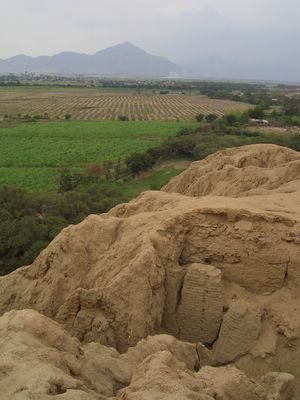Diane: The Moche culture flourished here from 100 A.D. to 750 A.D. Not much was known about this civilization until recently. Huaqueros (grave-robbers is a loose translation) found the pyramid-tomb of the Lord of Sipán and were quickly emptying it of its valuable gold objects and selling them overseas. After hundreds of years of near-continuous looting up and down Peru's coast, this tomb from the 3rd century had remained undisturbed until 1987. Once the archaeologists were called in, they were able to stop the illegal removal of artifacts and begin a meticulous excavation of this tomb.
The structures were several stories high, composed of millions of adobe bricks, and had collapsed for the most part. Many items were found crushed, but in place. Putting ornaments, clothing, and skeletons back together was a mammoth job. And the funeral rituals that the tomb revealed were horrific, if you ask me. An extraordinary museum, Museo Tumbas Reales Sipán, exhibits the high quality, crafted funerary objects, the layout of the tombs, and the monumental efforts required during the excavation. The museum does a magnificent job, but it took effort on my part to distract my attention from the fact that seven people were murdered and buried alongside the Big Kahuna.
So, what did they find? First off there were a thousand ceramic pots with food to make the journey to the next world. Below that was a guard sacrificed to protect the Lord. His feet were cut off, to "symbolically" prevent any dereliction of duty. The Lord of Sipán was buried in extreme ceremonial dress with huge gold-and-turquoise earrings, breastplates of precious spondylus shell beads strung together, a necklace of gold spheres, a necklace of gold and silver peanut-shells, a gold scepter showing human sacrifices, and other paraphernalia. There were lots of semi-precious stones. It was lavish - up there with the funerary objects found with King Tut. Surrounding the Lord of Sipán were the other human sacrifices, including 3 young women, a child, a military general, 2 llamas, and a dog.
The archaeologists uncovered 10 other tombs. An earlier tomb housed the "Old" Lord of Sipán. The craftwork in his tomb was amazing. A high priest also had his own tomb. These tombs showed that the Moche were really big on hierarchy. The kings, priests, and military leaders were highly memorialized and their images enshrined on murals and ceramics throughout their territory. The Lord of Sipán, himself, held sway in all three realms, as the civil, religious, and military leader.
A lot of the artwork depicted prisoners, military leaders, deities, and decapitations. They were big on depicting prisoners and decapitations. They even had a specialized weapon, a tumi, which was used for decapitating people.
Update: We visited the actual Sipán site toward the end of our stay in Chiclayo. What political jockeying must have gone on to build the museum with all the actual artifacts so far away from the excavation site. What is left of these vast adobe structures are now mere mud mountains surrounded by fields.


Another impressive civilization was the Sicán (or Lambayeque). Their influence lasted from 750 A.D. to 1375 A.D. Some royal Sicán tombs weren't discovered until 1991. And so there is another impressive museum, Museo Sicán. The museum explains two tombs. One tomb has the king buried in a deep vertical shaft upside down with his decapitated head placed in front of him. He was surrounded by (+/-)20 murdered young women to meet his needs in the next life. In addition there was more than a ton of metal objects, including lots of gold.
The Sicán made distinctive masks that were stolen and are now located in private collections the world over.
We took an open-air taxi ride further down the road to the dry forest reserve where these tombs were found. One algorrobo tree in this reserve is believed to be 800 years old. Shamans believe it has healing properties and conduct ceremonies here. We hung out there for a short time, soaking up its essence.
The forest itself was amazing, in that it grew out of the sand in an area that receives very little rain. It was also depressing. Although a protected reserve, local people continue to cut trees for firewood and dig around the pyramid sites hoping to steal a bit of their country's archaeological heritage. As we walked we passed people with loads of wood on their backs, on their bicycles, and on their burros walking down the primary access road in and out of the park. We did not hear a peep from a park ranger.
In addition to these extraordinary tombs, a great legacy of the Sicán culture was their ceramic, metal, and irrigation technologies. They were the first to produce bronze objects in northern Peru. They used moulds to make ceramic containers. They also were very successful in bringing irrigation to this desert area - cultivating more land than is in cultivation today.
I had heard of neither the Moche nor the Sicán cultures, before reading about them in my guidebook. I don't know anyone who has visited these world-class museums, but they are truly a find. Since many of these areas are still under excavation, there is still a lot left to learn. I must admit that I am glad I did not live in those times. With no definitive explanations, an extrapolation of their burial practices reveals two brutal cultures. Of course I pretty much feel the same way about all the major, long-gone cultures of Mexico and points south in the Americas including the Spanish.

No comments:
Post a Comment